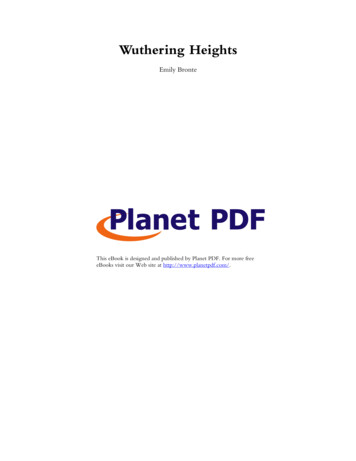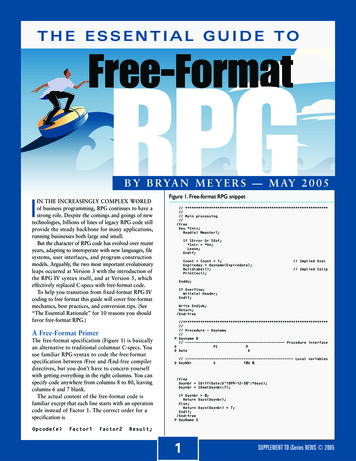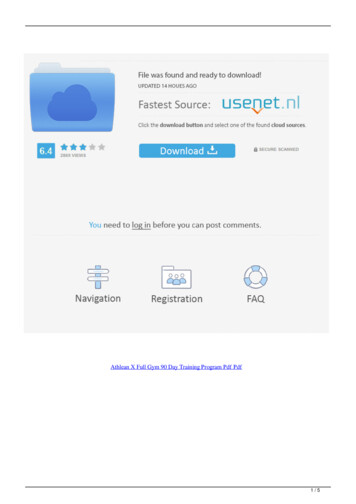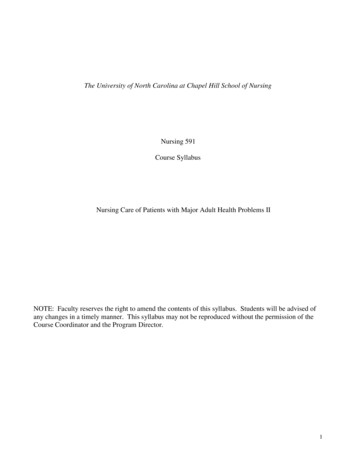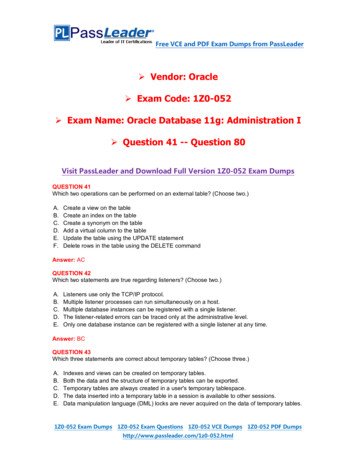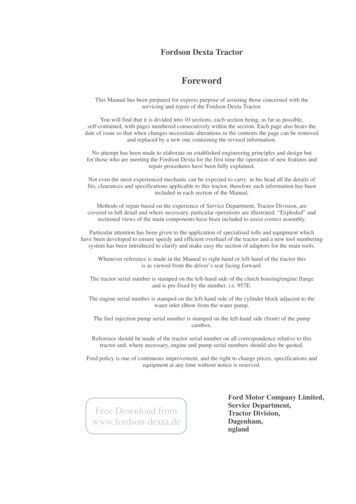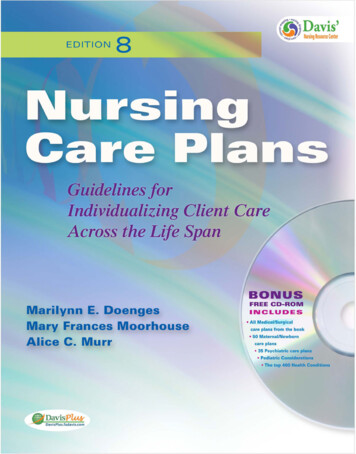
Transcription
INDEX OF DISEASES/DISORDERSAcid-base imbalancesrespiratory, 195metabolic, 483AIDS, 709Alcohol: acute withdrawal, 819Alzheimer’s disease, 764Amputation, 646Anemia–iron deficiency, anemia of chronicdisease, pernicious, aplastic, hemolytic, 493Angina (coronary artery disease, acute coronarysyndrome), 64Anorexia nervosa, 369Aplastic anemia, 493Appendectomy, 344Asthma, 120Bariatric surgery, 396Benign prostatic hyperplasia, 588Bulimia nervosa, 369Burns: thermal, chemical, and electrical—acuteand convalescent phases, 667Cancer, 846Cardiac surgery: postoperative care, 100Cardiomyoplasty, 100Cerebrovascular accident/stroke, 238Chemical burns, 667Cholecystectomy, 364Cholecystitis with cholelithiasis, 357Cholelithiasis, 357Chronic obstructive pulmonary disease, 120Cirrhosis of the liver, 445Colostomy, 334Coronary artery bypass graft, 100Coronary artery disease, 64Craniocerebral trauma–acute rehabilitativephase, 220Crohn’s disease, 321Deep vein thrombosis, 111Dementia (Alzheimer’s type or vascular), 764Diabetes mellitus/diabetic ketoacidosis, 405Diabetic ketoacidosis, 405Disaster considerations, 876Disc surgery, 262Dysrthymias , 88Eating disorders: anorexia nervosa/bulimianervosa, 369Eating disorders: obesity, 387Electrical burns, 667End-of-life care/hospice, 866Enteral feeding, 469Esophageal bleeding, 306Extended care, 801Fecal diversions: postoperative care of ileostomyand colostomy, 334Fluid and electrolyte imbalances, 903Fluid and electrolyte imbalances, 903Fractures, 632Gastrectomy/gastric resection, 317Gastric bypass, 396Gastric partitioning, 396Gastroplasty, 396Glaucoma, 204Graves’ disease, 419Heart failure: chronic, 48Hemodialysis, 575Hemolytic anemia, 493Hemothorax, 154Hepatitis, 434Herniated nucleus pulposus (ruptured invertebraldisc), 254HIV-positive client, 697Hospice, 866Hypercalcemia (calcium excess), 927Hyperkalemia (potassium excess), 921Hypermagnesemia (magnesium excess), 932Hypernatremia (sodium excess), 915Hypertension: severe, 37Hyperthyroidism (Graves’ disease,thyrotoxicosis), 419Hypervolemia (extracellular fluid volumeexcess), 905Hypocalcemia (calcium deficit), 924Hypokalemia (potassium deficit), 918Hypomagnesemia (magnesium deficit), 930Hyponatremia (sodium deficit), 914Hypovolemia (extracellular fluid volumedeficit), 908Hysterectomy, 611Ileostomy, 334Inflammatory bowel disease: ulcerative colitis,Crohn’s disease, 321Iron deficiency anemia, 493Laminectomy, 262Laryngectomy (postoperative care), 160Leukemias, 516Lung cancer: postoperative care, 144Lymphomas, 525Mastectomy, 619Metabolic acid-base imbalances, 483Metabolic acidosis—primary base bicarbonatedeficiency, 483Metabolic alkalosis—primary base bicarbonateexcess, 488Minimally invasive direct coronary arterybypass, 100Multiple sclerosis, 290Myocardial infarction, 74Obesity, 387Obesity: bariatric surgery–gastric partitioning/gastroplasty, gastric bypass, 396Pancreatitis, 458Parenteral feeding, 469Pediatric considerations, 890Peritoneal dialysis, 570Peritonitis, 349Pernicious anemia, 493Pneumonia, 131Pneumothorax, 154Primary base bicarbonate deficiency, 483Primary base bicarbonate excess, 488Primary carbonic acid deficit, 200Primary carbonic acid excess, 195Prostatectomy, 596Psychosocial aspects of care, 749Pulmonary emboli considerations, 111Pulmonary tuberculosis, 186Radical neck surgery: laryngectomy(postoperative care), 160Renal calculi, 603Renal dialysis, 560Renal failure: acute, 536Renal failure: chronic, 548Respiratory acid-base imbalances, 195Respiratory acidosis (primary carbonic acidexcess), 195Respiratory alkalosis (primary carbonic aciddeficit), 200Rheumatoid arthritis, 729Ruptured invertebral disc, 254Seizure disorders, 210Sepsis, 686Septicemia, 686Sickle cell crisis, 503Spinal cord injury (acute rehabilitative phase),271Stroke, 238Substance dependence/abuse rehabilitation, 835Surgical intervention, 782Thermal burns, 667Thrombophlebitis: deep vein thrombosis (includingpulmonary emboli considerations), 111Thyroidectomy, 429Thyrotoxicosis, 419Total joint replacement, 655Total nutritional support: parenteral/enteralfeeding, 469Transplantation considerations—postoperativeand lifelong, 739Tuberculosis, pulmonary, 186Ulcerative colitis, 321Upper gastrointestinal/esophageal bleeding, 306Urinary diversions/urostomy (postoperativecare), 578Urolithiasis (renal calculi), 603Urostomy, 578Valve replacement, 100Vascular dementia, 764Ventilatory assistance (mechanical), 173
KEY TO ESSENTIAL TERMINOLOGYClient Assessment DatabaseProvides an overview of the more commonly occurring etiology and coexisting factors associated with a specific medicaland/or surgical diagnosis as well as the signs and symptoms and corresponding diagnostic findings.Nursing PrioritiesEstablishes a general ranking of needs and concerns on which the Nursing Diagnoses are ordered in constructing the plan ofcare. This ranking would be altered according to the individual client situation.Discharge GoalsIdentifies generalized statements that could be developed into short-term and intermediate goals to be achieved by the clientbefore being “discharged” from nursing care. They may also provide guidance for creating long-term goals for the client towork on after discharge.Nursing DiagnosisThe general need or problem (diagnosis) is stated without the distinct cause and signs and symptoms, which would be addedto create a client diagnostic statement when specific client information is available. For example, when a client displaysincreased tension, apprehension, quivering voice, and focus on self, the nursing diagnosis of Anxiety might be stated: severeAnxiety related to unconscious conflict, threat to self-concept as evidenced by statements of increased tension, apprehension;observations of quivering voice, focus on self.In addition, diagnoses identified within these guides for planning care as actual or risk can be changed or deleted andnew diagnoses added, depending entirely on the specific client information.May Be Related to/Possibly Evidenced byThese lists provide the usual or common reasons (etiology) why a particular need or problem may occur with probable signsand symptoms, which would be used to create the “related to” and “evidenced by” portions of the client diagnostic statementwhen the specific situation is known.When a risk diagnosis has been identified, signs and symptoms have not yet developed and therefore are not included inthe nursing diagnosis statement. However, interventions are provided to prevent progression to an actual problem. The exception to this occurs in the nursing diagnosis risk for Violence, which has possible indicators that reflect the client’s risk status.Desired Outcomes/Evaluation Criteria—Client WillThese give direction to client care as they identify what the client or nurse hopes to achieve. They are stated in general termsto permit the practitioner to modify or individualize them by adding time lines and specific client criteria so they become“measurable.” For example, “Client will appear relaxed and report anxiety is reduced to a manageable level within 24 hours.”Nursing Outcomes Classification (NOC) labels are also included. The outcome label is selected from a standardizednursing language and serves as a general header for the outcome indicators that follow.Actions/InterventionsNursing Interventions Classification (NIC) labels are drawn from a standardized nursing language and serve as a generalheader for the nursing actions that follow.Nursing actions are divided into independent—those actions that the nurse performs autonomously; and collaborative—those actions that the nurse performs in conjunction with others, such as implementing physician orders. The interventions inthis book are generally ranked from most to least common. When creating the individual plan of care, interventions would normally be ranked to reflect the client’s specific needs and situation. In addition, the division of independent and collaborative isarbitrary and is actually dependent on the individual nurse’s capabilities and hospital and community standards.RationaleAlthough not commonly appearing in client plans of care, rationale has been included here to provide a pathophysiologicalbasis to assist the nurse in deciding about the relevance of a specific intervention for an individual client situation.Clinical PathwayThis abbreviated plan of care or care map is event- or task-oriented and provides outcome-based guidelines for goal achievement within a designated length of stay. Several samples have been included to demonstrate alternative planning formats.
NURSING DIAGNOSES ACCEPTED FORUSE AND RESEARCH FOR 2009–2011Activity Intolerance [specify level]Activity Intolerance, risk forActivity Planning, ineffectiveAirway Clearance, ineffectiveAllergy Response, latexAllergy Response, risk for latexAnxiety [specify level]Anxiety, deathAspiration, risk forAttachment, risk for impairedAutonomic DysreflexiaAutonomic Dysreflexia, risk forBehavior, risk-prone healthBleeding, risk forBody Image, disturbedBody Temperature, risk for imbalancedBowel IncontinenceBreastfeeding, effectiveBreastfeeding, ineffectiveBreastfeeding, interruptedBreathing Pattern, ineffectiveCardiac Output, decreasedCaregiver Role StrainCaregiver Role Strain, risk forChildbearing Process, readiness for enhancedComfort, impairedComfort, readiness for enhancedCommunication, impaired verbalCommunication, readiness for enhancedConflict, decisionalConflict, parental roleConfusion, acuteConfusion, risk for acuteConfusion, chronicConstipationConstipation, perceivedConstipation, risk forContaminationContamination, risk forCoping, defensiveCoping, ineffectiveCoping, readiness for enhancedCoping, ineffective communityCoping, readiness for enhanced communityCoping, compromised familyCoping, disabled familyCoping, readiness for enhanced familyDeath Syndrome, risk for sudden infantDecision-Making, readiness for enhancedDenial, ineffectiveDentition, impairedDevelopment, risk for delayedDiarrheaDignity, risk for compromised humanDistress, moralDisuse Syndrome, risk forDiversional Activity, deficientElectrolyte Imbalance, risk forEnergy Field, disturbedEnvironmental Interpretation Syndrome, impairedFailure to Thrive, adultFalls, risk forFamily Processes, dysfunctionalFamily Processes, interruptedFamily Processes, readiness for enhancedFatigueFearFeeding Pattern, ineffective infantFluid Balance, readiness for enhanced[Fluid Volume, deficient hyper/hypotonic]Fluid Volume, deficient [isotonic]Fluid Volume, excessFluid Volume, risk for deficientFluid Volume, risk for imbalancedGas Exchange, impairedGlucose Level, risk for unstable bloodGrievingGrieving, complicatedGrieving, risk for complicatedGrowth, risk for disproportionateGrowth and Development, delayedHealth Maintenance, ineffectiveHealth Management, ineffective self [formerlyTherapeutic Regimen Management, ineffective]Health Management, readiness for enhanced self[formerly Therapeutic Regimen Management,readiness for enhanced]Home Maintenance, impairedHope, readiness for y, disturbed personalImmunization Status, readiness for enhancedInfant Behavior, disorganizedInfant Behavior, readiness for enhanced organizedInfant Behavior, risk for disorganizedInfection, risk forInjury, risk forInjury, risk for perioperative positioningInsomniaIntracranial Adaptive Capacity, decreasedJaundice, neonatalKnowledge, deficient [Learning Need] [specify]Knowledge [specify], readiness for enhancedLifestyle, sedentaryLiver Function, risk for impairedLoneliness, risk forMaternal/Fetal Dyad, risk for disturbedMemory, impairedMobility, impaired bedMobility, impaired physicalMobility, impaired wheelchairMotility, dysfunctional gastointestinalMotility, risk for dysfunctional gastointestinalNauseaNeglect, selfNeglect, unilateralNoncompliance [Adherence, ineffective] [specify]Nutrition: less than body requirements, imbalancedNutrition: more than body requirements, imbalancedNutrition: more than body requirements, risk forimbalancedNutrition, readiness for enhancedOral Mucous Membrane, impairedPain, acutePain, chronicParenting, impairedParenting, readiness for enhancedParenting, risk for impairedPerfusion, ineffective peripheral tissuePerfusion, risk for decreased cardiac tissuePerfusion, risk for ineffective cerebral tissePerfusion, risk for ineffective gastrointestinalPerfusion, risk for ineffective renalPeripheral Neurovascular Dysfunction, risk forPoisoning, risk forPost-Trauma Syndrome [specify stage]Post-Trauma Syndrome, risk forPower, readiness for enhancedPowerlessness [specify level]Powerlessness, risk forProtection, ineffectiveRape-Trauma Syndrome(Rape-Trauma Syndrome: compound reaction—retired 2009)(Rape-Trauma Syndrome: silent reaction—retired2009)Relationship, readiness for enhancedReligiosity, impairedReligiosity, risk for impairedReligiosity, readiness for enhancedRelocation Stress SyndromeRelocation Stress Syndrome, risk forResilience, impaired individualResilience, readiness for enhancedResilience, risk for compromisedRole Performance, ineffectiveSelf-Care, readiness for enhancedSelf-Care Deficit: bathingSelf-Care Deficit: dressingSelf-Care Deficit: feedingSelf-Care Deficit: toiletingSelf-Concept, readiness for enhancedSelf-Esteem, chronic lowSelf-Esteem, situational lowSelf-Esteem, risk for situational lowSelf-MutilationSelf-Mutilation, risk forSensory Perception, disturbed (specify: visual,auditory, kinesthetic, gustatory, tactile, olfactory)Sexual DysfunctionSexuality Pattern, ineffectiveShock, risk forSkin Integrity, impairedSkin Integrity, risk for impairedSleep, readiness for enhancedSleep DeprivationSleep Pattern, disturbedSocial Interaction, impairedSocial IsolationSorrow, chronicSpiritual DistressSpiritual Distress, risk forSpiritual Well-Being, readiness for enhancedStress OverloadSuffocation, risk forSuicide, risk forSurgical Recovery, delayedSwallowing, impaired(Therapeutic Regimen Management, effective—retired 2009)(Therapeutic Reg
the nursing diagnosis statement. However, interventions are provided to prevent progression to an actual problem. The excep-tion to this occurs in the nursing diagnosis risk for Violence, which has possible indicators that reflect the client’s risk status. Desired Outcomes/Evaluation Criteria—Client Will
